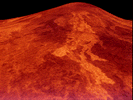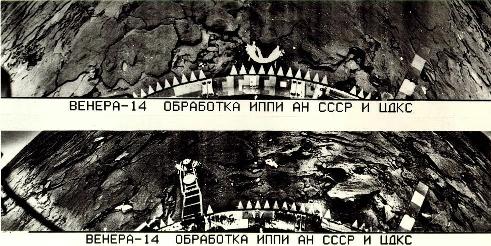 There is definite evidence of active geology on the surface of Venus:
There is definite evidence of active geology on the surface of Venus:- Very young surface, witnessed by the small number of impact craters
- Evidence of recent lava flows, suggesting liquid mantle is near surface.
- Distortions and Surface features consistent with crust movement and mantle convection.
Recall, Venus has a similar mass and radius to Earth, meaning internal heating of the core should exist like on Earth. It certainly has a molten rocky mantle. Venus also has an Fe/Ni core like Earth--though NO Magnetic field! This means one of two things: 1) the central core may be solid or 2) it could be Venus' slow rotation is unable to create a proper dynamo.
Geological History of Venus
There are three major mountain belts on Venus, with elevations of 5-8 km.
However, there is not a strong distinction between continents and ocean
basins, like on Earth. Mountain belts and low regions on Venus do not show the
same relationship to tectonic features as on Earth, such as mountain
ranges where plates are pushing together on Earth, or linear
structures outlining fault lines or subduction zones. The upper crust is being
moved around by what is assumed to be a convective mantle. However, the crust
does not move as individual plates. Activity is instead seen in volcanos
and corona.

A view of the surface of Venus, from the Russian Venera spacecraft
The hot surface temperature of Venus may have played a part in Venus' geological history. By keeping the surface rock near its boiling point, the surface is flexible and not able to form ridges and mountains, though it does create deformations.
But how do we explain its young surface?
Something caused the entire surface to be overturned, less than a billion years ago.
Such catastrophic events may have occurred before, and may explain a solid core: such
events release a tremendous amount of heat and might have quickly cooled Venus'
central core.